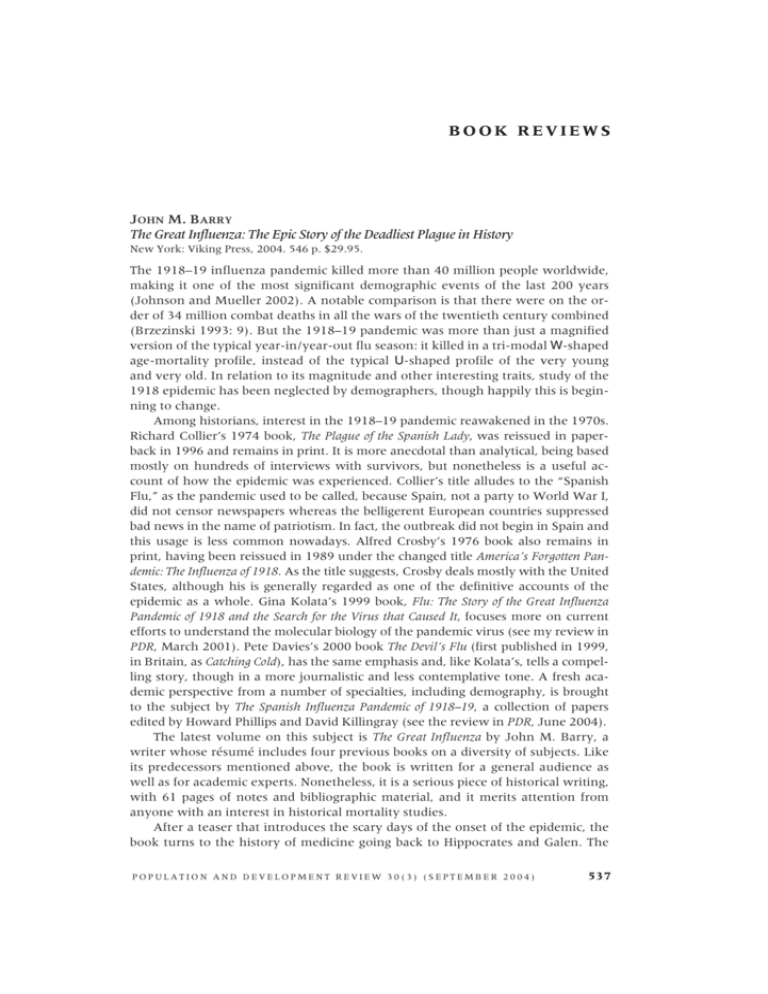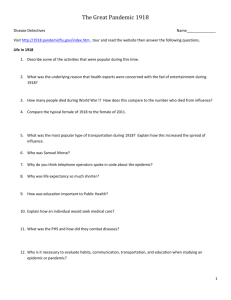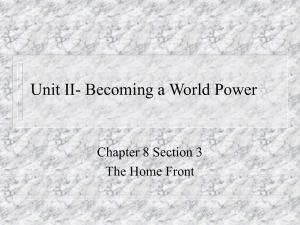book reviews
advertisement

BOOK REVIEWS JOHN M. BARRY The Great Influenza: The Epic Story of the Deadliest Plague in History New York: Viking Press, 2004. 546 p. $29.95. The 1918–19 influenza pandemic killed more than 40 million people worldwide, making it one of the most significant demographic events of the last 200 years (Johnson and Mueller 2002). A notable comparison is that there were on the order of 34 million combat deaths in all the wars of the twentieth century combined (Brzezinski 1993: 9). But the 1918–19 pandemic was more than just a magnified version of the typical year-in/year-out flu season: it killed in a tri-modal W-shaped age-mortality profile, instead of the typical U-shaped profile of the very young and very old. In relation to its magnitude and other interesting traits, study of the 1918 epidemic has been neglected by demographers, though happily this is beginning to change. Among historians, interest in the 1918–19 pandemic reawakened in the 1970s. Richard Collier’s 1974 book, The Plague of the Spanish Lady, was reissued in paperback in 1996 and remains in print. It is more anecdotal than analytical, being based mostly on hundreds of interviews with survivors, but nonetheless is a useful account of how the epidemic was experienced. Collier’s title alludes to the “Spanish Flu,” as the pandemic used to be called, because Spain, not a party to World War I, did not censor newspapers whereas the belligerent European countries suppressed bad news in the name of patriotism. In fact, the outbreak did not begin in Spain and this usage is less common nowadays. Alfred Crosby’s 1976 book also remains in print, having been reissued in 1989 under the changed title America’s Forgotten Pandemic: The Influenza of 1918. As the title suggests, Crosby deals mostly with the United States, although his is generally regarded as one of the definitive accounts of the epidemic as a whole. Gina Kolata’s 1999 book, Flu: The Story of the Great Influenza Pandemic of 1918 and the Search for the Virus that Caused It, focuses more on current efforts to understand the molecular biology of the pandemic virus (see my review in PDR, March 2001). Pete Davies’s 2000 book The Devil’s Flu (first published in 1999, in Britain, as Catching Cold), has the same emphasis and, like Kolata’s, tells a compelling story, though in a more journalistic and less contemplative tone. A fresh academic perspective from a number of specialties, including demography, is brought to the subject by The Spanish Influenza Pandemic of 1918–19, a collection of papers edited by Howard Phillips and David Killingray (see the review in PDR, June 2004). The latest volume on this subject is The Great Influenza by John M. Barry, a writer whose résumé includes four previous books on a diversity of subjects. Like its predecessors mentioned above, the book is written for a general audience as well as for academic experts. Nonetheless, it is a serious piece of historical writing, with 61 pages of notes and bibliographic material, and it merits attention from anyone with an interest in historical mortality studies. After a teaser that introduces the scary days of the onset of the epidemic, the book turns to the history of medicine going back to Hippocrates and Galen. The POPULATION AND DEVELOPMENT REVIEW 30(3) (SEPTEMBER 2004) 537 538 PDR 30(3) BOOK REVIEWS development of American medicine and medical education is emphasized, with the founding of Johns Hopkins University used as an example. The opening sections on medical history effectively set the stage for the remainder of the book, but they could be skimmed (or skipped) by readers whose interest lies strictly with the flu epidemic. The heart of the book interleaves the story of the epidemic, mostly in the United States, with an explanation of the basic biology of influenza. The Great Influenza effectively uses World War I as a backdrop. America did not enter the hostilities until 1917, and Barry documents well how the concentration of draftees at army camps around the country and the movement of troops from camp to camp helped to spread the epidemic (and, possibly, how the movement of American troops to Europe helped spread the pandemic). War rallies and Liberty Bond drives also helped spread influenza among the civilian population. A shortage of nurses exacerbated medicine’s inability to cope with the epidemic, which hit city after city like a tidal wave: “On the single day of October 10, the epidemic alone killed 759 people in Philadelphia. Prior to the outbreak, deaths from all causes—all illnesses, all accidents, all suicides, and all murders—averaged 485 a week” (p. 329, emphasis in the original). The aforementioned W-shaped age-mortality profile is described without using graphs or tables (p. 239), a sure sign that this book is aimed largely at the general nonfiction market. Barry endorses an immune-response theory of the mortality curve, namely that the central mode of the W was due to the fact that young adults have the strongest immune systems. Perversely, stronger immune response led to more fluid in the lungs, which led to death. That is probably not the whole story: the unusual mortality profile is often attributed to a prior epidemic conferring partial immunity to cohorts above a certain age (see Kolata, p. 300). One of the major strengths of this book is the way in which Barry explains the basic biology and epidemiology of influenza. During the epidemic the cause of influenza was uncertain, and many suspected Pfeiffer’s bacillus (Hemophilus influenzae). This bacterium can cause meningitis, but influenza is caused by the influenza A virus. Barry shows how an incorrect hypothesis may become reinforced: failure to find Pfeiffer’s bacillus in pathology samples in 1918 was dismissed as a lack of proper laboratory skill as opposed to evidence against an etiological link. Especially well conveyed is how the state of technology biased investigators toward bacteria, which could be cultured, stained, and examined under the microscope. Viruses were known to be infectious agents capable of passing through bacteria-blocking ceramic filters, but were otherwise shrouded in mystery. Without electron microscopy, genetic analysis, and x-ray crystallography—techniques that would come later—viruses were poorly understood. Barry is a skilled writer, and his book is easy to read even when he explains technical material or offers historical details. But he is not an especially efficient writer. He often uses repetition to achieve emphasis, resulting in frequent sensations of déjà lu. The ironic use of “this was only influenza” as a leitmotif becomes annoying after a point. Another fault is Barry’s tendency to over-explain things, such as the one-sentence paragraph: “The study of epidemic disease is, of course, a prime focus of public health” (p. 87). This point, if not self-evident, was already made in the book, most recently on the previous page. In my view, however, these weaknesses do not detract from the merit of the book as a whole. BOOK REVIEWS PDR 30(3) 539 The Great Influenza is richly detailed, and Barry uses detail to good effect, drawing the reader into the story. On the other hand, some anecdotes (for example, one about tension between army regulars and recent draftees at Camp Funston, Kansas, in 1918), though well researched, do not really advance the story of the 1918 flu epidemic. Perhaps this reflects my demographic or epidemiological bias, but I found that the book was strongest when it was most focused on events directly related to the influenza outbreak. More seriously, not all the anecdotes are documented by sources in the endnotes. This presents a cardinal problem when judging the book as a piece of historical research. For example, the vividly detailed description of the suicide of Colonel Charles Hagadorn, commander of an army camp that suffered many influenza deaths, differs substantively from the Associated Press daily wire account of the same event that was published in the Boston Evening Transcript on 8 October 1918 and in both the New York Times and Los Angeles Times on the following day. Barry, unfortunately, fails to indicate the source of his version of the story. The 1918–19 influenza pandemic continues to interest many, and emerging diseases such as SARS (severe acute respiratory syndrome), in some ways similar to influenza and also caused by a virus, reinforce this interest. For demographers curious to learn more about 1918–19 outbreak, it is a tough choice between Crosby’s book and Barry’s. Barry does a more thorough job of explaining the biology of influenza. Crosby is more succinct, which should be appealing for someone who wants to learn a lot about the epidemic quickly. I think Crosby’s is still the definitive volume, but like all important subjects the 1918–19 pandemic can tolerate more than one book, and The Great Influenza is a welcome and worthy addition to scholarship on one of the most important demographic events of modern times. University of California Berkeley ANDREW NOYMER References Brzezinski, Zbigniew. 1993. Out of Control: Global Turmoil on the Eve of the Twenty-First Century. New York: Scribner. Collier, Richard. 1996 (1974). The Plague of the Spanish Lady: The Influenza Pandemic of 1918– 1919. London: Macmillan. Crosby, Alfred W. 1989 (1976). America’s Forgotten Pandemic: The Influenza of 1918. Cambridge: Cambridge University Press. Davies, Pete. 2000 (1999). The Devil’s Flu: The World’s Deadliest Influenza Epidemic and the Scientific Hunt for the Virus that Caused It. New York: Henry Holt. Johnson, Niall P. and Juergen Mueller. 2002. “Updating the accounts: Global mortality of the 1918–1920 ‘Spanish’ influenza pandemic,” Bulletin of the History of Medicine 76(1):105–115. Kolata, Gina. 1999. Flu: The Story of the Great Influenza Pandemic of 1918 and the Search for the Virus that Caused It. New York: Farrar, Straus and Giroux. Phillips, Howard and David Killingray (eds.). 2003. The Spanish Influenza Pandemic of 1918– 19: New Perspectives. London and New York: Routledge.




